1993 CHEVROLET CAVALIER engine overheat
[x] Cancel search: engine overheatPage 195 of 308
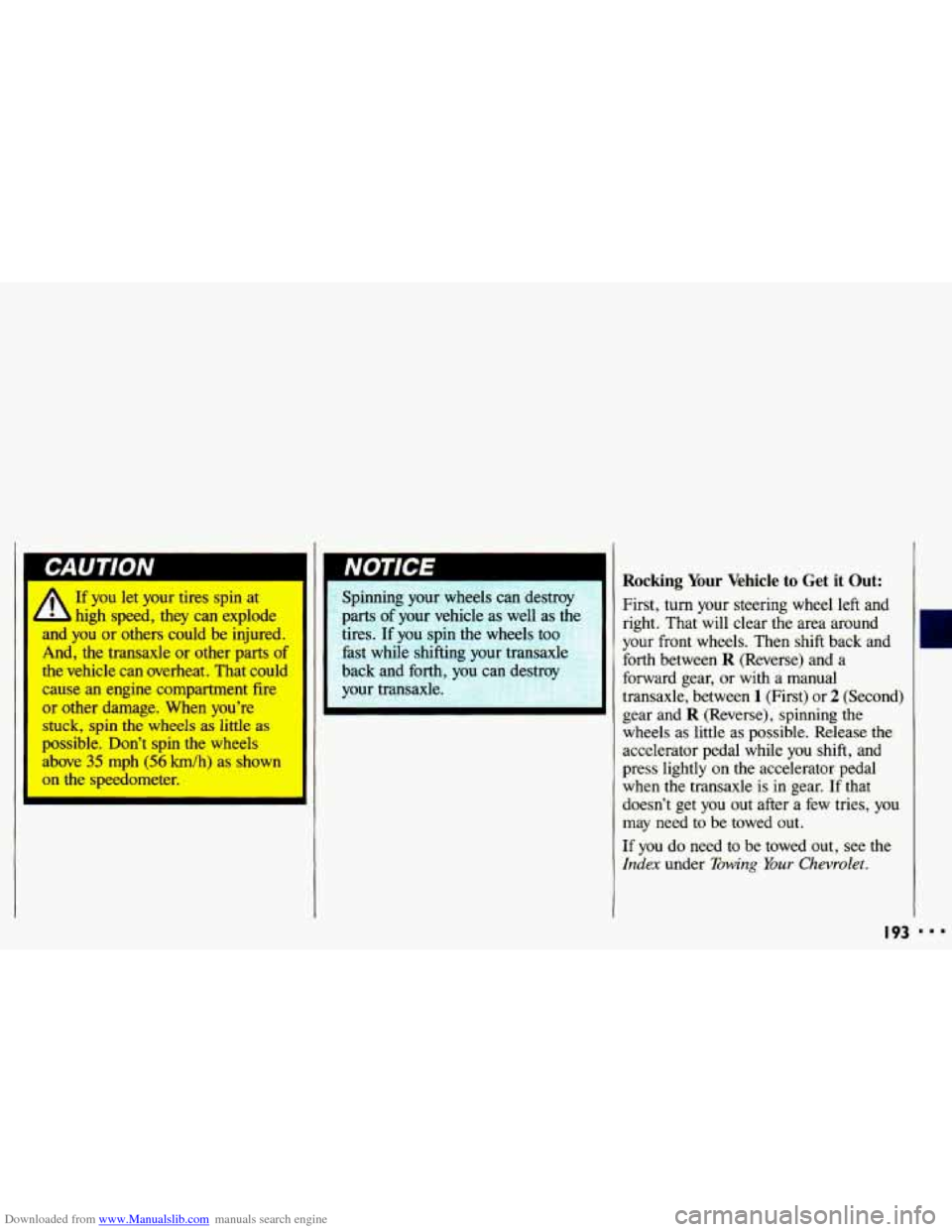
Downloaded from www.Manualslib.com manuals search engine If you let your tires spin at
- high speed, they can explode
and you or others could be injured.
And, the transaxle or other parts of
the vehicle can overheat. That could
cause an engine compartment fire
or other damage. When you’re
stuck, spin
the wheels as little as
possible. Don’t spin the wheels
above
35 mph (56 h/h) as shown
on
the speedometer. Spinning
your wheels can destroy
parts
of your vehicle as well as the
tires.
If you spin the wheels too
fast while shifting your transa:
back and forth, you can destroy
your transaxle.
-
Rocking Your Vehicle to Get it Out:
First, turn your steering wheel left and
right. That will clear the area around
your front wheels. Then shift back and
forth between
R (Reverse) and a
forward gear, or with a manual
transaxle, between
1 (First) or 2 (Second)
gear and
R (Reverse), spinning the
wheels as little as possible. Release
the
accelerator pedal while you shift, and
press lightly on the accelerator pedal
when the transaxle is in gear. If that
doesn’t get you out after a few tries,
you
may need to be towed out.
If
you do need to be towed out, see the
Index under Towing Your Chevrolet.
I93
Page 218 of 308
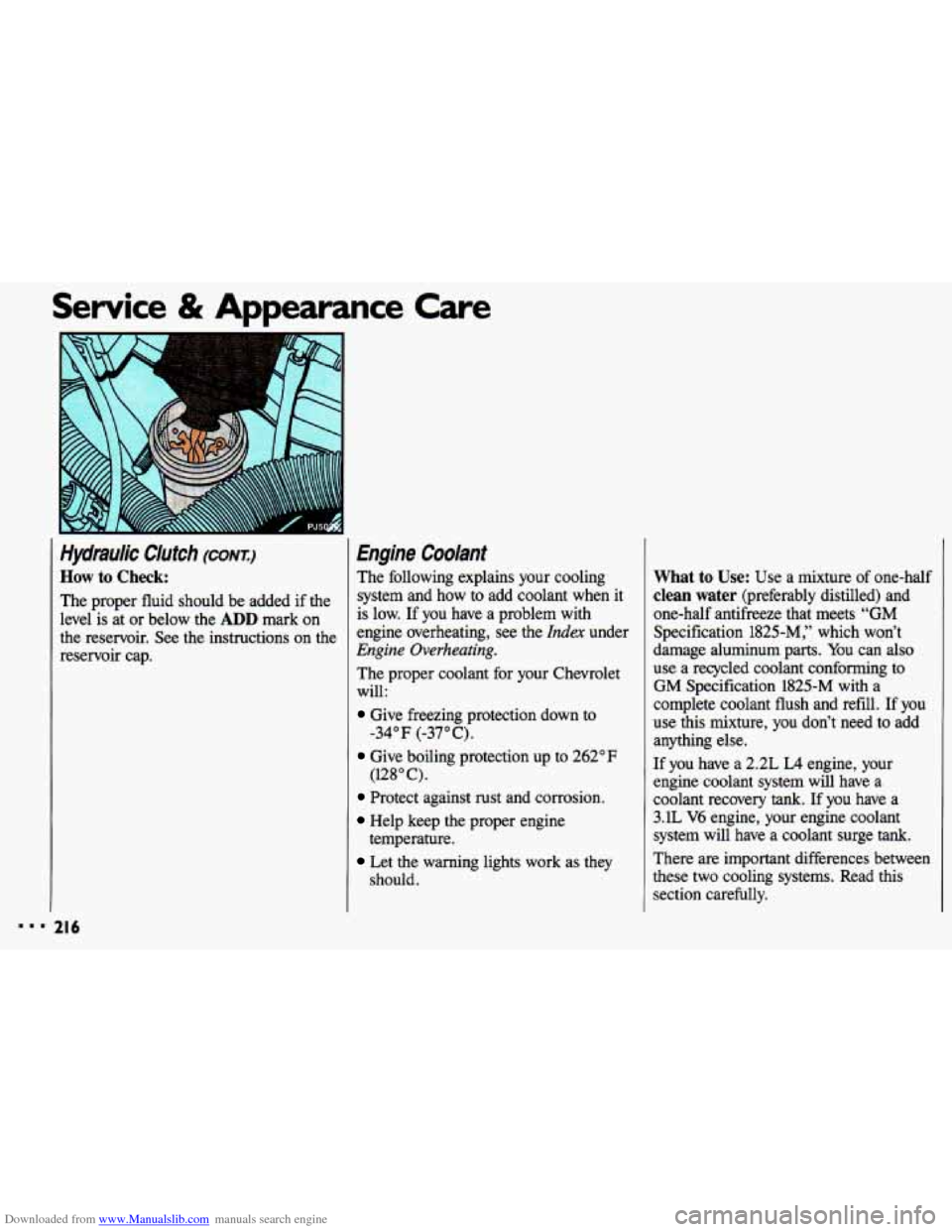
Downloaded from www.Manualslib.com manuals search engine 888
Service rance Care
Hydraulic Clutch (CONTJ
How to Check:
The proper fluid should be added if the
level is at or below the
ADD mark on
the reservoir.
See the instructions on the
reservoir cap.
216
Engine Coolant
The following explains your cooling
system and how to add coolant when it
is low. If you have a problem with
engine overheating,
see the Index under
Engine Overheating.
The proper coolant for your Chevrolet
will:
Give freezing protection down to
Give boiling protection up to 262°F
Protect against rust and corrosion.
Help keep the proper engine
Let the warning lights work as they
-34" F (-37" C).
(128" C).
temperature.
should.
What to Use: Use a mixture of one-half
clean water (preferably distilled) and
one-half antifreeze that meets "GM
Specification 1825-M," which won't
damage aluminum parts.
You can also
use a recycled coolant conforming to
GM Specification 1825-M with a
complete coolant flush and refill.
If you
use this mixture, you don't need to add
anything else.
If you have a 2.2L LA engine, your
engine coolant system will have a
coolant recovery
tank. If you have a
3.1L V6 engine, your engine coolant
system will have a coolant surge
tank.
There are important differences between
these two cooling systems. Read this section carefully.
Page 219 of 308
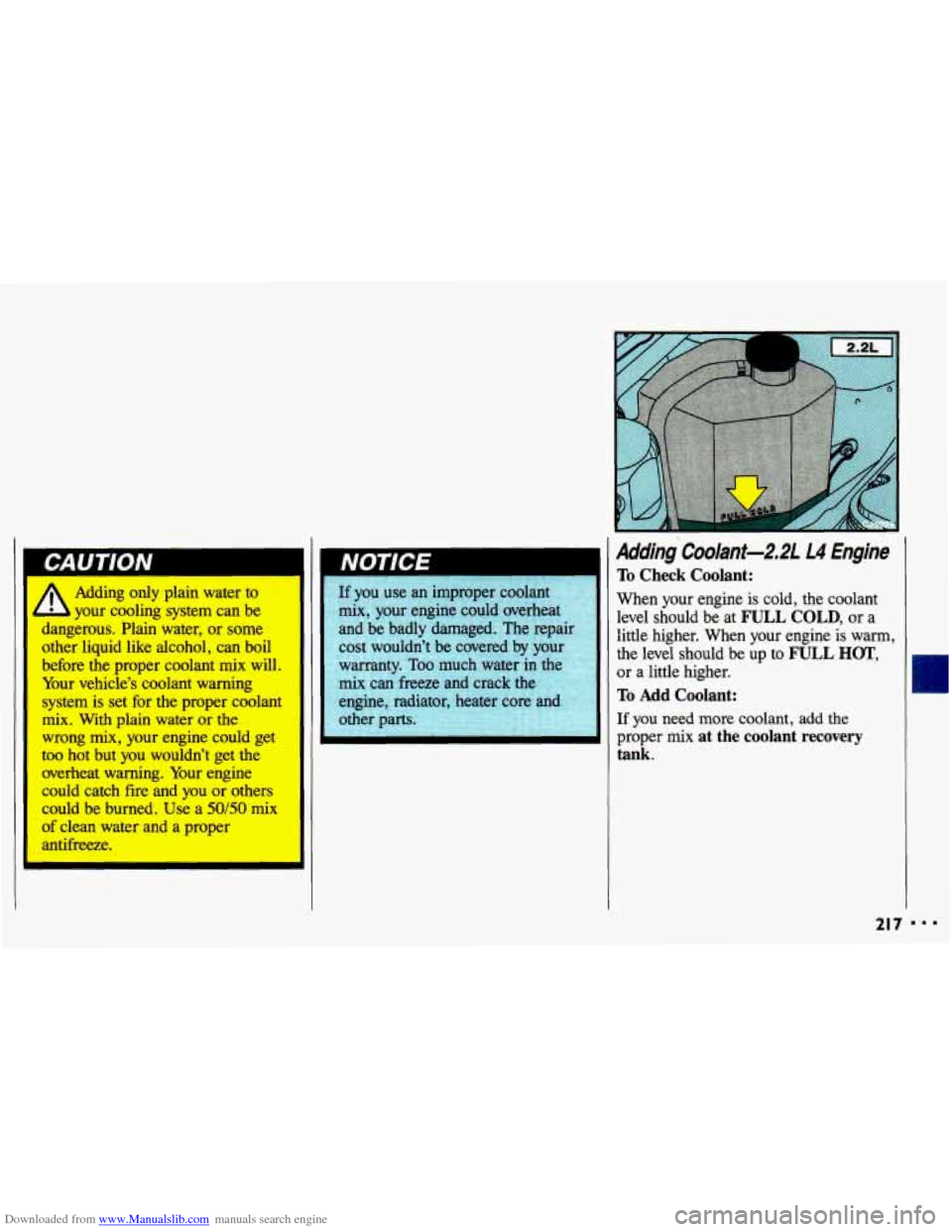
Downloaded from www.Manualslib.com manuals search engine L Adding only plain water to - your cooling system can be
dangerous. Plain water,
or some
other liquid like alcohol, can boil
before the proper coolant
mix will.
Your vehicle's coolant warning
system
is set for the proper coolant
mix. With plain water or the
wrong mix, your engine could get
too hot but
you wouldn't get the
overheat warning. Your engine
could catch
fire and you or others
could be burned. Use a
50150 mix
of clean water and a proper
antifreeze.
Adding Coolant-2,21 L4 Engine
To Check Coolant:
When your engine
is cold, the coolant
level should be at
FULL COLD, or a
little higher. When your engine
is warm,
the level should be up to
mJLL HOT,
or a little higher.
To Add Coolant:
If you need more coolant, add the
proper
mix at the coolant recovery
tank.
Page 221 of 308
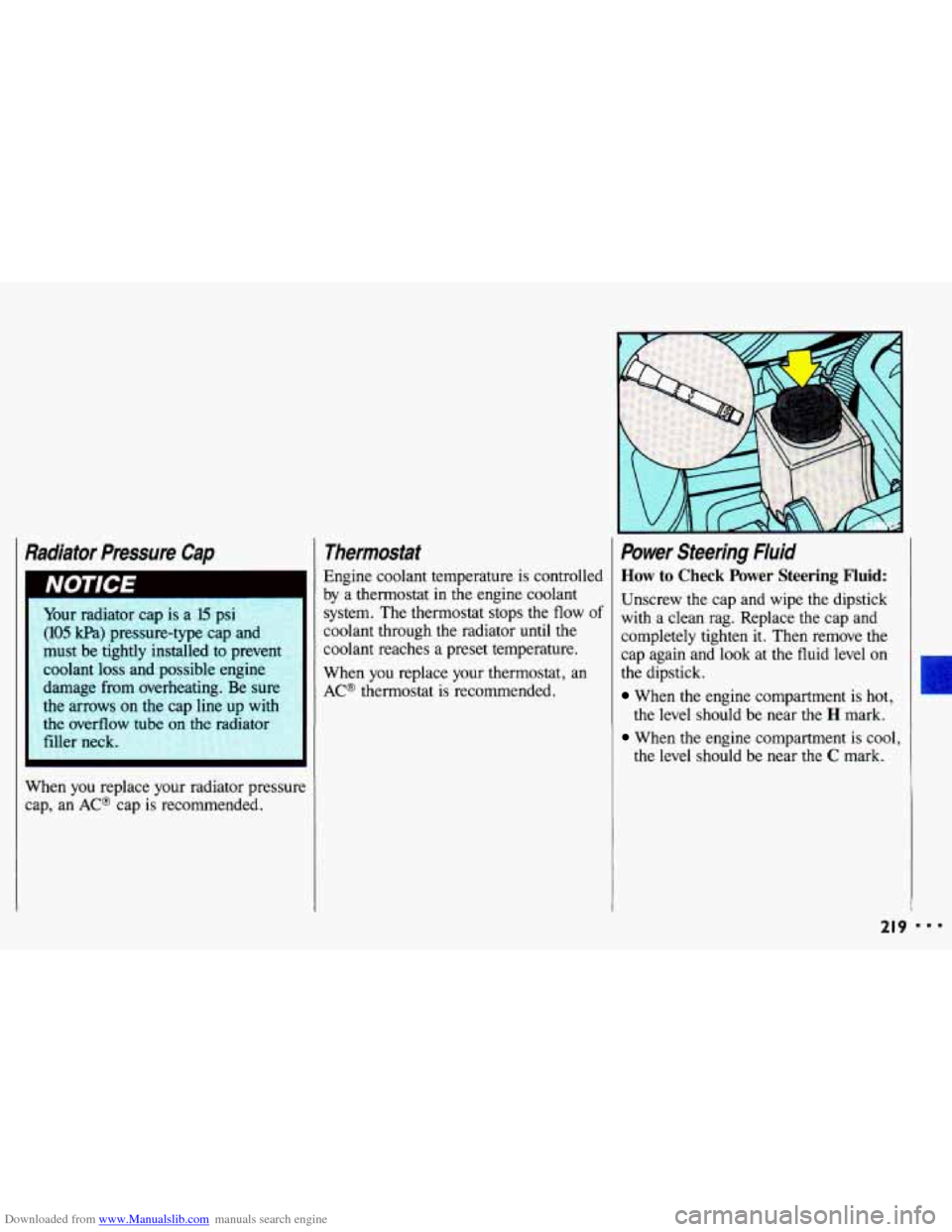
Downloaded from www.Manualslib.com manuals search engine Radiator Pressure Cap
, .. g.., ',!: Your radiator cap is a 15 psi
I.,, ''.' (105 kPa) pressure-type cap and
,;:, must be tightly installed to prevent
'.. coolant loss and possible engine
.':: damage from overheating. Be sure
.; the arrows on the cap line up with
the overflow
tube on the radiator
Y; _/,.__ filler neck.
When you replace your radiator pressurl
cap, an
AC@ cap is recommended.
.. . ..
~. .
..
F+
Thermostat
Engine coolant temperature is controlled
by a thermostat in the engine coolant
system. The thermostat stops the
flow of
coolant through the radiator until the
coolant reaches a preset temperature.
When you replace your thermostat, an
AC@ thermostat is recommended.
Power Steering Fluid
How to Check Power Steering Fluid:
Unscrew the cap and wipe the dipstick
with a clean rag. Replace the cap and
completely tighten it. Then remove the
cap again and
look at the fluid level on
the dipstick.
When the engine compartment is hot,
the level should be near the H mark.
When the engine compartment is cool,
the level should be near the
C mark.
21 9 I..
Page 231 of 308
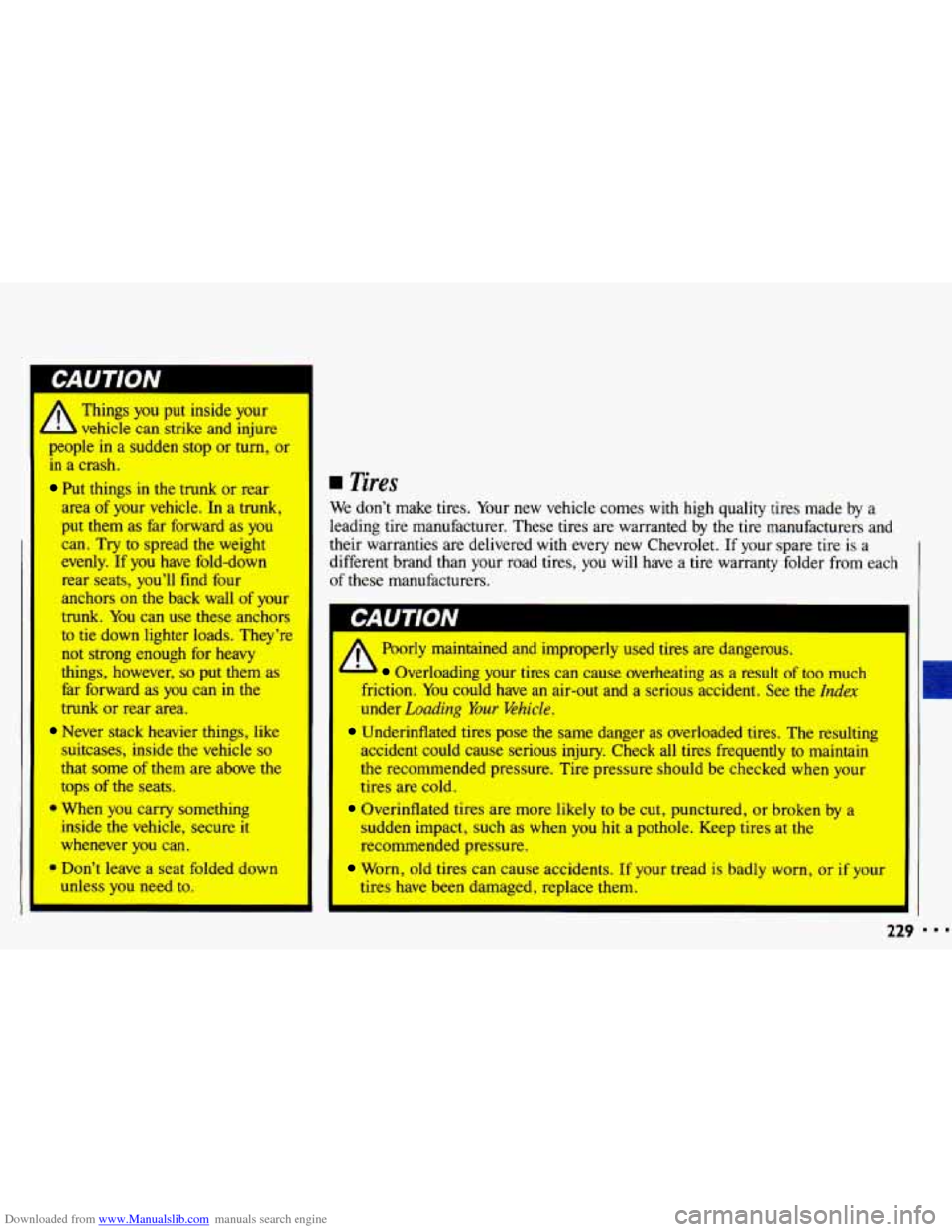
Downloaded from www.Manualslib.com manuals search engine 1--
-
Things you=
strike and injure
people in
a sudden stop or turn, or
in
a crash.
Put things in the trunk or rear
area
of your vehicle. In a trunk,
put them as hr forward as you
can.
Try to spread the weight
evenly.
If you have fold-down
rear seats, you’ll find four
anchors on the back wall
of your
trunk.
You can use these anchors
to tie down lighter loads. They’re
not strong enough for
heavy
things, however, so put them as
fbr forward
as you can in the
trunk or rear area.
Never stack heavier things, like
suitcases, inside the vehicle
so
that some of them are above the
tops
of the seats.
e When you carry something
inside the vehicle, secure it
whenever you can.
unless you need to.
0 Don’t leave a seat folded down
I
Tires
We don’t make tires. Your new vehicle comes with high quality tires made by a
leading tire manufacturer. These tires are warranted by the tire manufacturers and
their warranties are delivered with every
new Chevrolet. If your spare tire is a
different brand than your road tires,
you will have a tire warranty folder from each
of these manufacturers.
I I
CAUTION
Poorly maintained and improperly used tires are dangerous. 1
’ - Overloading your tires can cause overheating as a result of too much
friction. You could have
an air-out and a serious accident. See the Index
under hading Your Vehicle.
Underinflated tires pose the same danger as overloaded tires. The resulting
accident could cause serious injury. Check all tires frequently to maintain
the recommended pressure. Tire pressure should be checked
when your
tires
are cold.
sudden impact:
such as when you hit a pothole. Keep tires at the
recommended pressure.
I Overinflated tires are more likely to be cut, punctured, or broken by a
Worn, old tires can cause accidents. If your tread is badly worn, or if your
I tires have been damaged, replace them. I
229
I
I..
Page 251 of 308
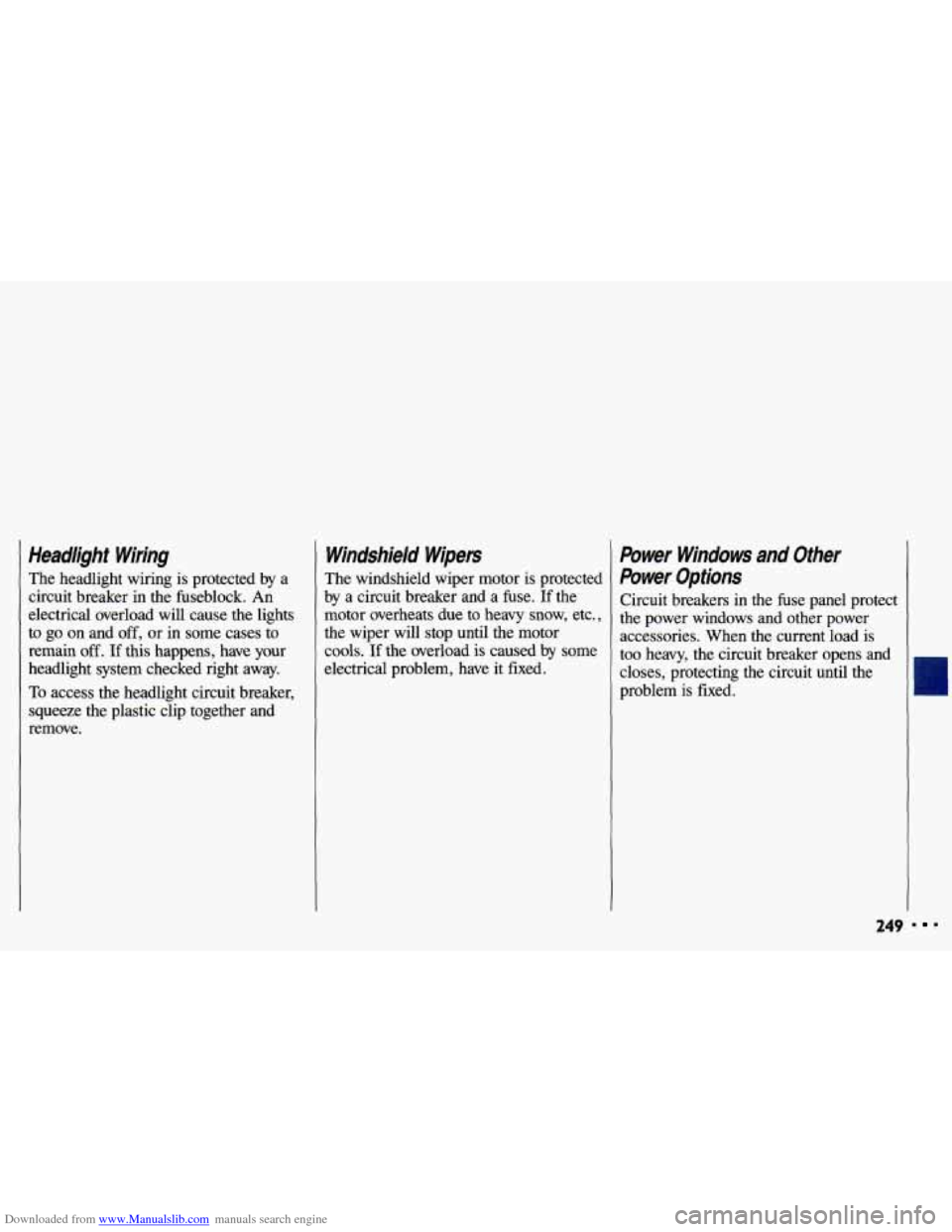
Downloaded from www.Manualslib.com manuals search engine Headlight Wiring
The headlight wiring is protected by a
circuit breaker in the fuseblock. An
electrical overload will cause the lights
to go on and
off, or in some cases to
remain
off. If this happens, have your
headlight system checked right away.
To access the headlight circuit breaker,
squeeze the plastic clip together and
remove.
Windsheld Wipers
The windshield wiper motor is protected
by a circuit breaker and a fuse.
If the
motor overheats due to heavy snow, etc.,
the wiper will stop until the motor
cools.
If the overload is caused by some
electrical problem, have it fixed.
Power Windows and Other
Power Options
Circuit breakers in the fuse panel protect
the power windows and other power
accessories. When the current load is
too heavy, the circuit breaker opens and
closes, protecting the circuit until the
problem is fixed.
249
Page 299 of 308
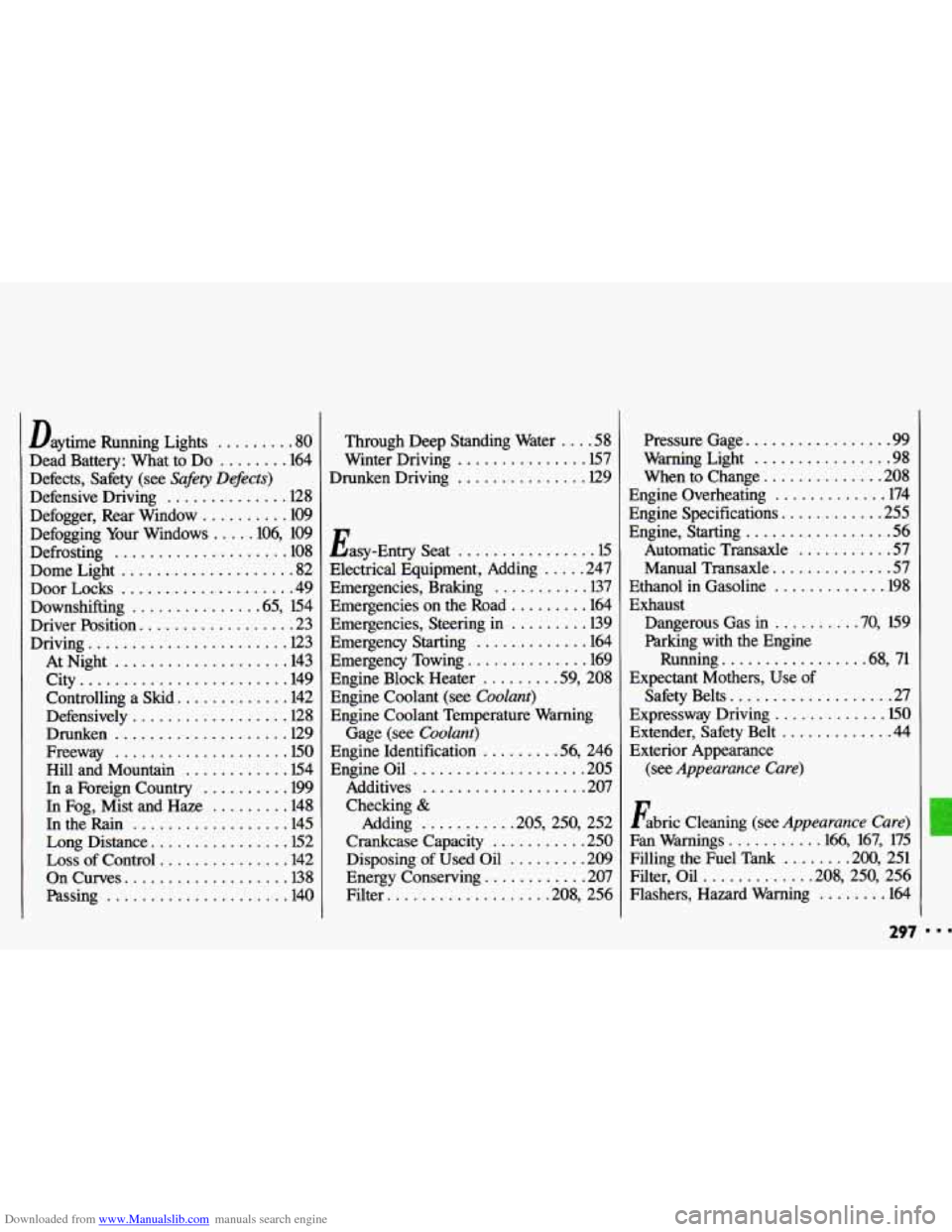
Downloaded from www.Manualslib.com manuals search engine Daytime Running Lights ........ -80
Dead Battery: What to Do ........ 164
Defects. Safety (see
Safety Defects)
Defensive Driving .............. 128
Defogger. Rear Window .......... 109
Defrosting
.................... 108
Dome Light
.................... 82
Door Locks
.................... 49
Downshifting
.............. .65. W4
Driver Position
.................. 23
Driving
....................... 123
At Night
.................... 143
City
........................ 149
Controlling a Skid
............. 142
Defensively
................. -128
Drunken .................... 129
Freeway
.................... 150
Hill and Mountain ............ 154
In a Foreign Country
.......... 199
In Fog, Mist and Haze ......... 148
In the Rain .................. 145
Long Distance
................ 152
Loss
of Control ............... 142
On Curves
................... 138
Passing
..................... 140
Defogging
Your Windows
.... .106. 109 Through
Deep Standing Water
.... 58
Winter Driving ............... 157
Drunken Driving
............... 129
n
Easy-Entry Seat ................ 15
Electrical Equipment. Adding ..... 247
Emergencies. Braking
........... 137
Emergencies on the Road
......... 164
Emergencies. Steering in
......... 139
Emergency
Starting ............. 164
Emergency Towing
.............. 169
Engine Block Heater
........ .59, 208
Engine Coolant (see
Coolant)
Engine Coolant Temperature Warning
Engine Identification
........ .56. 246
Engine Oil
.................... 205
Additives
................... 207
Checking
&
Adding .......... .205. 250. 252
Crankcase Capacity
........... 250
Disposing of Used Oil ......... 209
Energy Conserving
............ 207
Filter
.................. .208. 256
Gage
(see Coolant)
Pressure Gage ................. 99
Warning Light ................ 98
When to
Change .............. 208
Engine Overheating
............. 174
Engine Specifications
............ 255
Engine, Starting
................. 56
Automatic Transaxle ........... 57
Manual Transaxle
.............. 57
Ethanol in Gasoline ............. 198
Exhaust Dangerous
Gas in ......... .70, 159
Parking with the Engine Running
................ .68, 71
Expectant Mothers, Use of
Safety Belts
................... 27
Expressway Driving
............. 150
Extender. Safety Belt ............ -44
Exterior Appearance
(see
Appearance Care)
Fabric Cleaning (see Appearance Care)
Fan Warnings .......... .166. 167. 175
Filling
the Fuel Tank ....... .200. 251
Filter. Oil
............ .208, 250. 256
Flashers, Hazard Warning
........ 164
297 r
Page 300 of 308
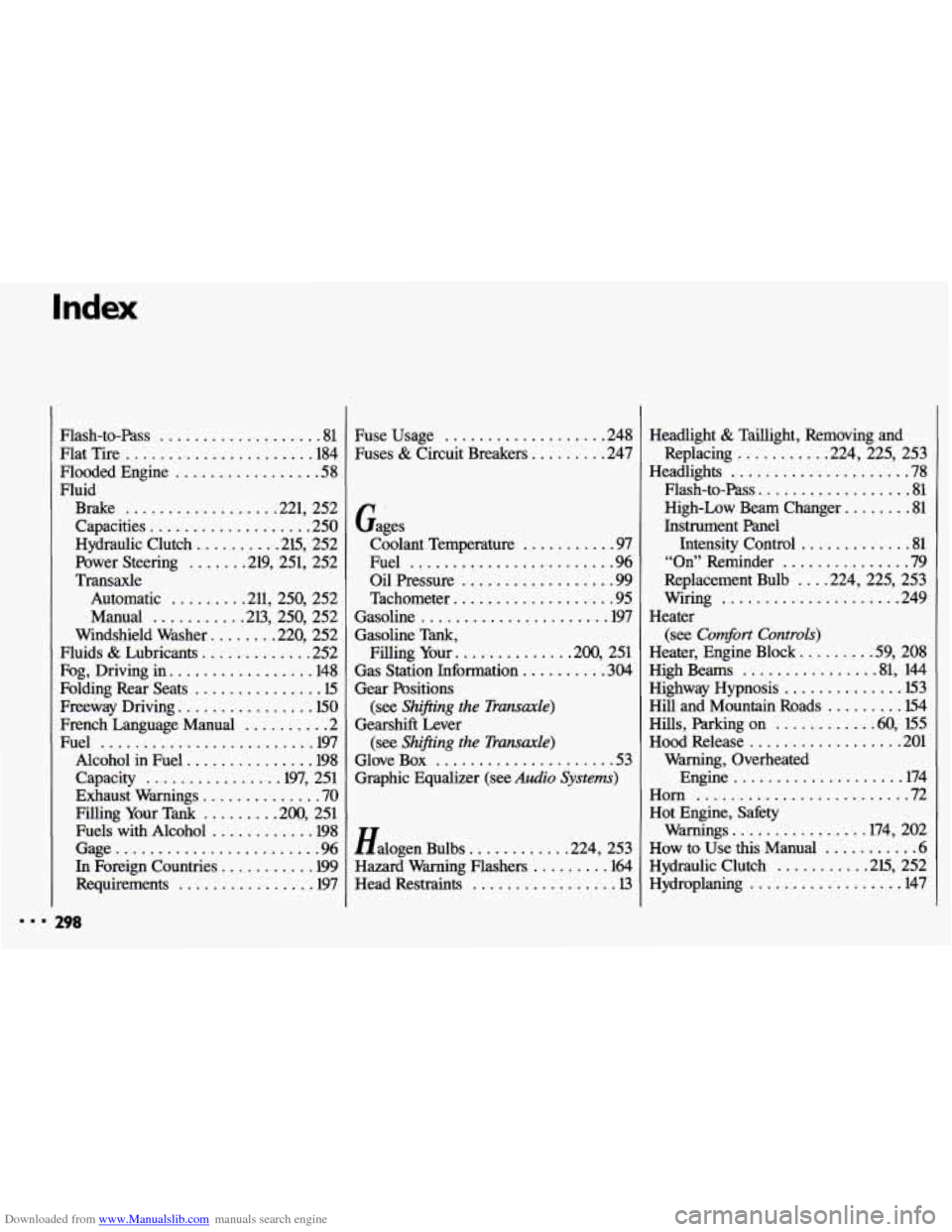
Downloaded from www.Manualslib.com manuals search engine Flash-to-Pass ................... 81
Flat Tire
...................... 184
Flooded Engine
................. 58
Fluid Brake
................. .221. 252
Capacities
................... 250
Hydraulic Clutch
......... .2l5. 252
Power Steering
...... .219. 251. 252
Transaxle
Automatic
........ .211. 250. 252
Manual
.......... .2l3. 250. 252
Windshield Washer
....... .220. 252
Fluids
& Lubricants ............. 252
Fog. Driving in
................. 148
Folding Rear Seats
............... l5
Freeway Driving ................ 150
French Language Manual .......... 2
Fuel
......................... 197
Alcohol in Fuel
............... 198
Capacity
............... .197. 251
Exhaust Warnings
.............. 70
Filling Your Tank
........ .200. 251
Fuels with Alcohol
............ 198
Gage
........................ 96
In Foreign Countries ........... 199
Requirements
................ 197
198
Fuse Usage ................... 248
Fuses
& Circuit Breakers ......... 247
Gaies Coolant Temperature
........... 97
Fuel
........................ 96
Oil Pressure
.................. 99
Tachometer
................... 95
Gasoline
...................... 197
Gasoline Tank. -Filling Your
............. .200. 251
Gas Station Information
.......... 304
Gear Positions
Gearshift Lever
Glove Box
.................... i., . 53
Graphic Equalizer (see
Audio Systems)
(see Shlfing the Transaxle)
(see Shifting the Transaxle)
Halogen Bulbs ........... .224. 253
Hazard Warning Flashers
........ -164
Head Restraints
................. 13
Headlight & Taillight. Removing and
Replacing
.......... .224. 225. 253
Headlights
..................... 78
Flash-to-Pass
.................. 81
High-Low Beam Changer
........ 81
Instrument Panel Intensity Control
............. 81
“On” Reminder
............... 79
Replacement Bulb
... .224. 225. 253
Wiring
..................... 249
(see
Comfort Controls)
Heater Heater. Engine Block
........ .59. 208
High Beams
............... .81. 144
Highway Hypnosis
.............. 153
Hill and Mountain Roads
......... 154
Hills. Parking on
........... .a. 155
Hood Release .................. 201
Engine
.................... 174
Horn
......................... 72
Hot Engine. Safety
Warnings
............... .174. 202
How to Use
this Manual ........... 6
Hydraulic Clutch .......... .2l5. 252
Hydroplaning
.................. 147
Warning. Overheated